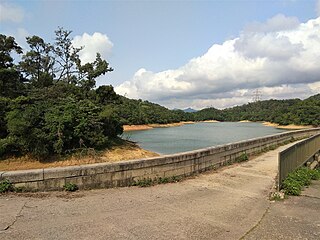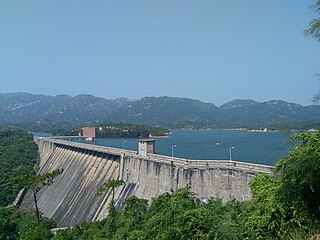History
Water rationing

Until 1964 water rationing - the act of limiting water usage for each household by water providers - was a constant reality for Hong Kong residents, occurring more than 300 days per year. The worst crisis occurred in 1963–64 when water was delivered only every 4 days for 4 hours each time. The territory, which was under the British colonial administration, then embarked on a three-pronged approach to supply water to an increasing population. (Hong Kong's population increased from 1.7 million in 1945 to about 6 million in 1992.) The strategy involved flushing toilets with seawater, the construction of larger freshwater reservoirs in bays that used to be covered by the sea, and water imports from mainland China. [3]
Seawater flushing
In 1955 seawater was first used to flush toilets in a pilot scheme. This was followed by the installation of seawater flushing systems in all new houses and in selected districts beginning in 1957. [4] In 1960 legislation was introduced to promote seawater flushing on a larger scale, followed by substantial investments in a separate network. However, the system was unpopular due to the need to build a separate plumbing network in each house. Seawater initially was sold, but from 1972 on it was provided for free and the costs of the system were recovered through the drinking water tariff. In 1991, about 65 percent of Hong Kong's households used seawater for flushing. By 1999, the number of conforming households had increased to 79 percent. [5]
Freshwater reservoirs in the sea

In 1957 construction began on the first dam that would close off a natural sea bay and create the Shek Pik Reservoir. The reservoir was built to store freshwater that previously had been "lost to the sea" during the rainy season. The reservoir was completed in 1963. The completion of the Shek Pik reservoir was followed by the construction of two larger reservoirs of the same type. After the Plover Cove Reservoir was completed in 1968, water rationing was discontinued until 1977. With the completion of the High Island Reservoir in 1978, continuous water supply was re-established. Water rationing was renewed for the last time in 1980–81. Between 1965 and 1982 water had to be rationed seven times, often for many months with interruptions of up to 16 hours per day. To maintain Hong Kong's competitiveness, rationing was imposed only on residential users. Industry, the city's main water user, was exempted from rationing. The need for rationing was finally overcome in 1982 thanks to water imports. [3]
Water imports

In 1960 Hong Kong began importing water from outside its borders through the Dongjiang – Shenzhen (Dongshen) Water Supply Scheme. After many extensions and upgrades, the current system consists of a pipeline from Qiaotou Town of Dongguan to a reservoir in Shenzhen next to Hong Kong. Water imports from the Pearl River have increased gradually from 23 million cubic meters per year (under a 1960 agreement) to 1100 million cubic meters per year (under a fifth agreement signed in 1989). Water imports thus played a crucial role in alleviating Hong Kong's water crisis, accounting for 70 percent of the territory's water supply in 1991. The People's Republic of China has never exercised the "water weapon" in its relationship with Hong Kong. China needed foreign exchange and between 1979 and 1991 alone Hong Kong paid China almost 4 billion Hong Kong Dollars (about US$500 million applying the 1991 exchange rate) for water imports. [3]
Desalination
Desalination was a source of water in Hong Kong between 1975 and 1981. A large desalination plant was commissioned in Lok On Pai in 1975, but was decommissioned again in 1981 because its operation was more expensive than importing water from Dongjiang. [5] Another pilot desalination plant utilized reverse osmosis in Tuen Mun in Hong Kong during the year of 2004, but this plant lasted only one year. This plant was made as an experiment to evaluate the efficiency of reverse osmosis. Desalination is an intriguing topic that would definitely increase the rate at which clean water can be supplied as well as help prevent the overuse of water pipes for transportation, but it is an expensive process that currently does not yield too many benefits. [6]
Protecting raw water quality
The pollution of raw water supplied to Hong Kong became an increasing concern that triggered a variety of activities designed to protect the quality of raw water. In 1998 the intake of the water pipeline was moved further upstream on the Dongjiang River where water quality was better. In 2003 an 83 km dedicated aqueduct was completed, thus reducing the vulnerability of the supply to pollution. Additionally, wastewater treatment plants were constructed in settlements in the Dongjiang basin and polluting industries were removed, thus protecting the water at the source. [7] In 2006 a Water Supply Agreement was signed with Guangdong Province for a "flexible" supply of Dongjiang water. [4] The agreement allows for less water to be withdrawn when reservoirs in Hong Kong are full, and more water to be withdrawn in times of drought, while the annual payment remains the same. Under the new agreement, Hong Kong paid fixed lump sums of HK$2,959 million, HK$3,146 million and HK$3,344 million for 2009, 2010 and 2011 respectively. [8]
Total water management
In 2003 the government of Hong Kong announced what it called a "total water management programme". In 2005 a study was commissioned and the results were broadly discussed. Based on the study the government reaffirmed its approach to water management, but also started new initiatives concerning leakage reduction, water conservation, greywater reuse, rainwater harvesting, as well as pilots for the reuse of reclaimed water and desalination. For example, the government plans to provide reclaimed water from Shek Wu Hui Sewage Treatment Works for consumers in Sheung Shui and Fanling for toilet flushing and other non-potable uses, as well as pilot desalination plants in Tuen Mun and Ap Lei Chau. [9]
Desalination comeback
Because the price of imported water increased from $1 to $3 per cubic meter, the Hong Kong authorities announced in 2011 that the government would build a 50,000 cubic metre per day seawater desalination plant. The plant will allow greater resiliency against droughts that may become more severe due to climate change. [10]










